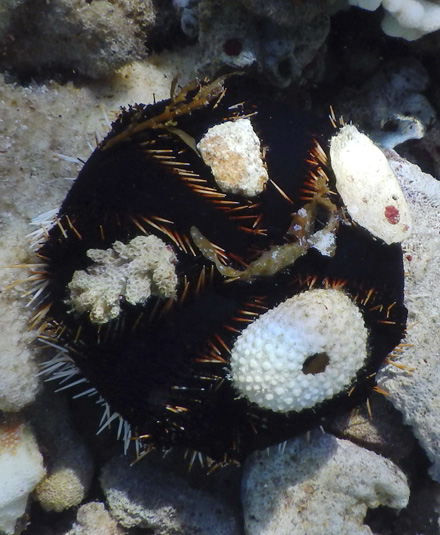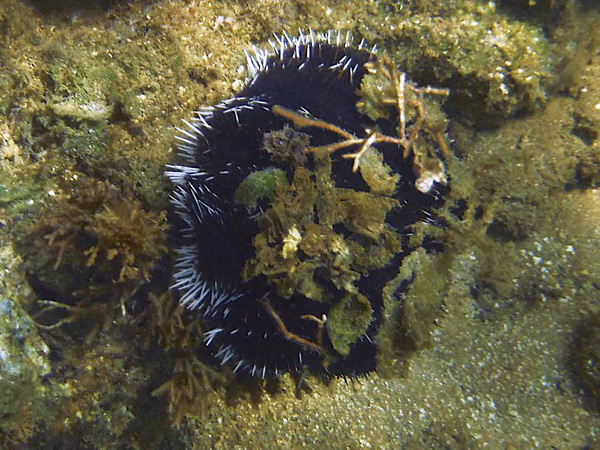Published in the Ocean Watch column, Honolulu Star-Advertiser © Susan Scott
November 24, 2014
Who knew that a poky marine animal the size of a snow globe could do such a stellar job of fighting aliens?
The plodding heroes are collector urchins, a native species the state has been raising by the thousands and releasing in Kaneohe Bay. There the sea urchins work like slow-motion Pac-Men, gobbling up weeds, the weeds in this case being three seaweed species gone to the dark side.
 A collector urchin is dotted with items it has picked up.
A collector urchin is dotted with items it has picked up.
©2014 Susan Scott
But we can’t blame the seaweeds. Industrial researchers brought the edible red algae, native to the Philippines and Malaysia, to Coconut Island in 1974 to raise for its rich carrageenan content.
A nearly endless number of foods and household products contain carrageenan, a thickener. On the long list are toothpaste, ice cream, beer, shampoo, diet soda, pet food, milk, jam and medicines.
Red algae aquaculture failed as a business, but the hardy seaweeds escaped and went wild. One species can double in size in 15 to 30 days, growing to 6 feet tall with a 1-inch-diameter base and sprawling, finger-thick branches. The dense stalks shield the bay’s native corals from the sunlight they need to live.
To keep the seaweeds from destroying Kaneohe Bay’s reefs, workers remove bulk weeds with a machine called the Super Sucker. Because bits of broken-off seaweed tips can quickly grow into mats, tens of thousands of algae-eating collector urchins are being released in the bay.
As vacuum cleaners of the reef, the urchins use hundreds of suction-cup feet to amble around, day and night, eating seaweed with a circle of five teeth at the center of their undersides. Following a Super Sucker session, the black whiskery creatures hoover their little hearts out.
Collector urchins are not the needle-sharp, long-spined sea urchins we call wana. Collectors, called hawae maoli in Hawaiian, are endearing little creatures with a touchable surface similar to a stiff hairbrush.
I have dozens of pictures of collector urchins because they wear silly hats, piling everything from rocks to plastic spoons to skeletons of their own babies on top of their round shells. Biologists think the animals’ hodgepodge collections act as shields from bright sun and might also disguise an urchin from fish and octopus predators. Whatever the reason, the results are adorable.
Our spheroid storm troopers might not have light sabers to battle plant aliens, but they’re making impressive progress with teeth and tube feet. May the Force be with them.
